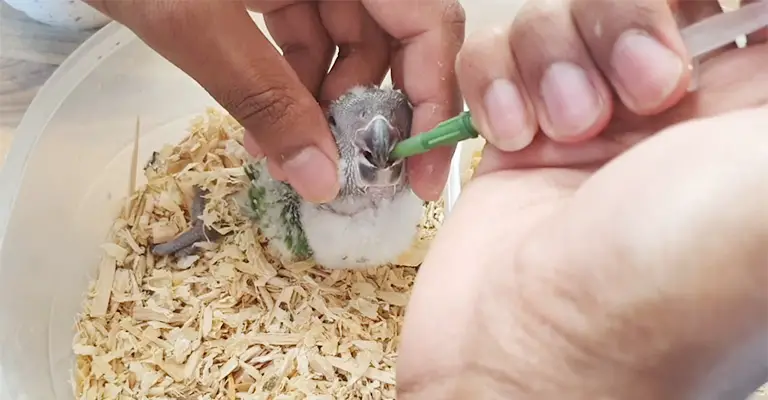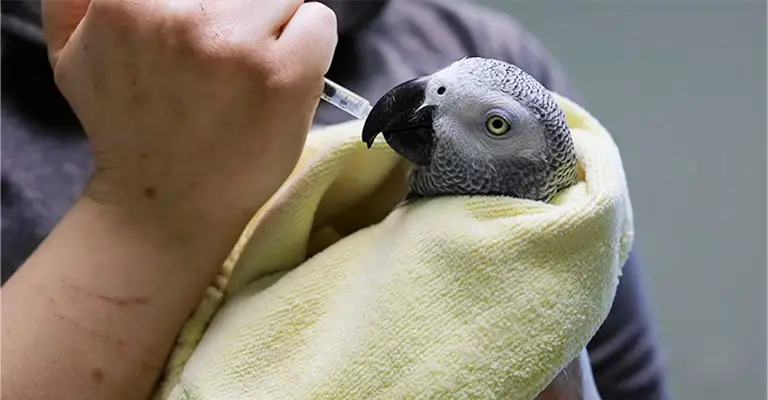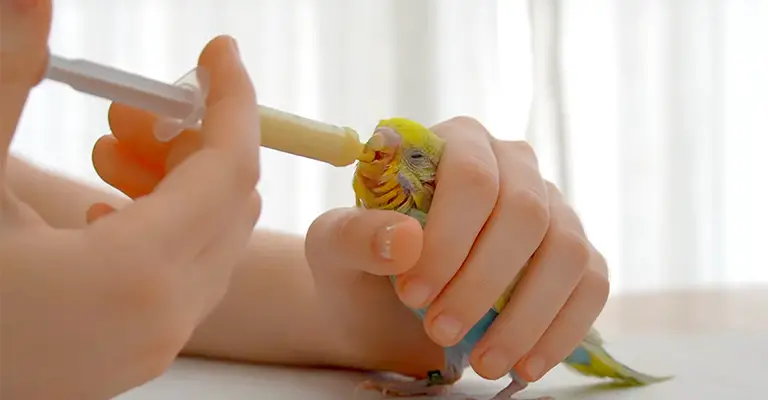Caring for injured or orphaned birds can be a rewarding yet delicate task. At times, it becomes necessary to step in and provide nourishment to a bird that cannot feed itself. Syringe feeding is a vital skill for bird enthusiasts, wildlife rehabilitators, and veterinarians alike.
This blog post delves into the intricacies of how to feed a bird with a syringe, emphasizing the importance of proper technique, patience, and the bird’s well-being.
Syringe feeding, while potentially life-saving, carries inherent risks such as aspiration, stress, and injury if not executed correctly. Understanding these risks and following best practices is paramount.
We will guide you through the process, from assembling the necessary equipment to monitoring the bird’s condition, ensuring you have the knowledge and confidence to provide crucial care when needed.

Should I Feed a Bird With a Syringe?
Feeding a bird with a syringe should be a last resort and only attempted under specific circumstances, such as when a bird is injured, orphaned, or unable to eat on its own. It requires expertise and caution to avoid causing harm.
Before attempting this, contact a local wildlife rehabilitator or an avian veterinarian for guidance, as they can provide proper instructions and assess the bird’s condition.
Using a syringe for bird feeding can risk aspiration if done incorrectly, where food enters the bird’s respiratory tract instead of the digestive system. Improper feeding techniques may also lead to injury or stress for the bird.
It’s essential to use the right type of food and ensure the syringe is clean and sterile. In most cases, it’s best to rely on professionals with experience in bird care to ensure the bird’s well-being and safety.
What You Will Need to Feed a Bird With a Syringe?
Feeding a bird with a syringe requires careful preparation and the right equipment to ensure the bird’s safety and well-being. Here’s what you’ll need:
- Syringe: Choose a syringe with a soft, flexible rubber or plastic tip, typically ranging from 1 to 10 ml in size. The tip should be wide enough to accommodate the bird’s beak without causing discomfort.
- Feeding Formula: Use an appropriate bird feeding formula, which you can usually obtain from a veterinarian or wildlife rehabilitator. These formulas are specially designed to provide the necessary nutrition for birds.
- Warm Water: You may need warm water to mix with the feeding formula to achieve the right consistency. Be sure the mixture is not too hot to avoid scalding the bird.
- Towels or Cloth: Have clean towels or cloths on hand to gently restrain the bird if necessary and to clean up any spills.
- Latex Gloves: Wearing disposable latex gloves can help maintain cleanliness and reduce the risk of infection.
- Small Dish or Container: Use a small dish or container to mix the formula and load it into the syringe.
- Scale: A scale can be useful to measure the correct amount of formula accurately.
- Tweezers or Forceps: These tools can be helpful for holding the bird’s beak open gently if needed.
- Feeding Tube (Optional): In some cases, a soft, flexible feeding tube may be required for precise feeding, especially for very small or delicate birds.
- Training and Guidance: Before attempting to feed a bird with a syringe, seek guidance from a veterinarian or wildlife rehabilitator. They can provide proper instructions and ensure you are using the correct techniques.
Feeding a bird with a syringe should be done with extreme care and ideally under the supervision or guidance of a professional.
Incorrect feeding can lead to aspiration, injury, or stress for the bird, so it’s essential to be well-prepared and knowledgeable about the specific needs of the bird species you’re caring for.
How to Feed a Bird With a Syringe?

Feeding a bird with a syringe requires patience, precision, and a gentle touch to ensure the bird’s safety. Here are step-by-step instructions on how to do it:
Prepare the Equipment
Gather all the necessary equipment, including the syringe, feeding formula, warm water, towels, and latex gloves. Ensure everything is clean and sterile to avoid infection.
Mix the Formula
Follow the instructions on the feeding formula packaging to mix the appropriate ratio of formula and warm water in a small dish or container. The formula should have a smooth, lump-free consistency.
Position the Bird
Place the bird on a clean, stable surface and gently secure it if necessary using a towel or cloth to minimize movement. Ensure the bird is comfortable and secure but not overly restrained.
Prepare the Syringe
Draw the prepared formula into the syringe, filling it to the appropriate volume for the bird’s needs. Remove any air bubbles by gently tapping the syringe and pushing them out.
Approach the Bird
Approach the bird calmly and gently, avoiding sudden movements that might startle it.
Feeding the Bird
Hold the syringe with the formula near the bird’s beak, allowing the bird to open its beak voluntarily. Do not force the beak open as this can cause injury or stress.
Gently insert the syringe’s tip into the side of the bird’s beak, angling it slightly toward the back of the throat. Be careful not to block the bird’s airway.
Slowly dispense a small amount of formula at a time, allowing the bird to swallow naturally. Watch for signs of swallowing, such as the bird moving its throat.
Avoid overfilling the bird’s mouth, which can lead to aspiration. Be patient and go at the bird’s pace. Do not rush or force the feeding.
Monitor the Bird
Keep an eye on the bird’s condition during and after feeding. Ensure it doesn’t show signs of distress, such as coughing or difficulty breathing.
Clean Up
After feeding, clean the syringe and any spilled formula promptly to maintain hygiene.
Record Keeping
Keep a record of the bird’s feedings, including the amount given and the time of each feeding. This information can be crucial for monitoring the bird’s progress.
Seek Professional Guidance
If you’re not experienced in feeding birds with syringes, seek guidance from a veterinarian or a wildlife rehabilitator. They can provide hands-on training and ensure you’re using the correct techniques for the specific bird species you’re caring for.
It’s crucial to prioritize the bird’s well-being and safety throughout the process, and professional guidance is highly recommended, especially for novice caregivers.
Benefits of Feeding a Bird With a Syringe

Feeding a bird with a syringe can be beneficial in specific situations, especially when the bird is injured, orphaned, or unable to eat on its own. Here are eight potential benefits of using this feeding method:
Nutrition and Hydration
Syringe feeding allows precise control over the bird’s food intake, ensuring it receives the necessary nutrition and hydration, which is critical for its health and recovery.
Medication Administration
If the bird requires medication, it can be mixed with the feeding formula and administered through the syringe, ensuring the bird receives its prescribed treatment accurately.
Customized Diet
With syringe feeding, you can tailor the diet to the bird’s specific needs. This is especially important for baby birds or those with dietary restrictions or health issues.
Weight Management
You can monitor the bird’s weight closely and adjust the feeding regimen accordingly. Maintaining the right weight is crucial for the bird’s overall health and recovery.
Rehabilitation Support
In cases of injured or weak birds, syringe feeding provides the necessary sustenance to support their recovery until they can eat independently.
Orphaned Bird Care
Orphaned baby birds often require syringe feeding as they are unable to feed themselves. This method ensures their survival until they fledge and become self-sufficient.
Controlled Feeding
Syringe feeding allows for controlled portions, reducing the risk of overfeeding or underfeeding, which can have detrimental effects on a bird’s health.
Bonding and Trust
When administered with care and gentleness, syringe feeding can help build trust between the caregiver and the bird. This trust can be valuable for the bird’s long-term well-being and successful release back into the wild.
While syringe feeding can be beneficial, it’s important to emphasize that it should be used as a last resort and under the guidance of professionals, such as wildlife rehabilitators or veterinarians.
Incorrect feeding techniques can lead to aspiration or injury, so it should only be attempted by those with proper training and experience in avian care. Additionally, the ultimate goal should be to transition the bird back to self-feeding as soon as it is capable.
Risk Factor of Feeding a Bird With a Syringe

Feeding a bird with a syringe can be a delicate process, and there are several risks involved, both for the bird and the caregiver. It’s essential to understand these risks and take necessary precautions. Here are eight potential risk factors associated with syringe feeding a bird:
Aspiration
One of the most significant risks is aspiration, where the formula enters the bird’s respiratory tract instead of the digestive system. This can lead to pneumonia or severe respiratory distress.
Injury
Improper handling or forceful feeding can cause injury to the bird’s beak, mouth, or throat. In some cases, the bird may become fearful or stressed, leading to self-inflicted injuries.
Stress
Handling and feeding a bird with a syringe can be stressful for the bird, especially if it’s not accustomed to human contact. Stress can weaken the bird’s immune system and overall health.
Infection
If equipment, formula, or hands are not properly sterilized, it can lead to infections in the bird. Birds have delicate immune systems, making them susceptible to bacterial or fungal infections.
Overfeeding
Feeding too much formula or feeding too quickly can overwhelm a bird’s digestive system, causing discomfort, regurgitation, or vomiting.
Malnutrition
If the formula used is not well-balanced or doesn’t meet the specific dietary needs of the bird species, it can lead to malnutrition, developmental issues, or deficiencies.
Dependency
Hand-raised birds may become dependent on human caregivers, making it challenging for them to integrate into the wild or socialize with their own species when released.
Regurgitation
Birds can regurgitate their food when stressed or if they’ve been overfed. This can further complicate feeding and cause nutritional imbalances.
To mitigate these risks, it’s crucial to seek guidance from experienced professionals, such as veterinarians or wildlife rehabilitators, before attempting syringe feeding.
They can provide proper training, ensure you use the right techniques, and advise on suitable formulas for the bird’s species and age.
Additionally, maintaining a clean and sterile environment and closely monitoring the bird’s condition during and after feedings can help minimize these risks.
Syringe feeding should always be a last resort, with the ultimate goal being the bird’s successful rehabilitation and return to the wild whenever possible.
FAQs
Not all birds can be syringe-fed. It’s crucial to identify the bird species and its specific dietary requirements. Consult a wildlife expert or veterinarian to ensure you’re using the correct feeding formula and technique for that species.
To prevent aspiration, feed the bird slowly, allowing it to swallow between small amounts of formula. Angle the syringe towards the back of the throat to avoid blocking the airway. Seek guidance from a professional for proper technique.
If the bird refuses to eat, don’t force it. Consult a professional for advice. It’s crucial to address the underlying issue, which could be stress, illness, or discomfort, before attempting to feed again.
Feeding frequency depends on the bird’s age and species. Newborn birds require frequent feedings, while older ones eat less frequently. Consult a wildlife rehabilitator or veterinarian for a feeding schedule tailored to the bird’s needs.
While it’s possible to use a regular syringe, it’s better to use a syringe specifically designed for feeding birds, with a soft, flexible tip. These are safer and more comfortable for both the bird and the caregiver, reducing the risk of injury.
Wrapping Up
Feeding a bird with a syringe can be a compassionate act that aids in its recovery and rehabilitation. However, it is not a task to be taken lightly.
As you embark on this journey of avian care, remember that seeking professional guidance and understanding the unique needs of the bird species in question are paramount.
The bond formed between caregiver and bird during these moments of nourishment can be profound, but it is the bird’s ultimate health and well-being that should remain at the forefront of every feeding endeavor.
With the knowledge shared in this blog post, you can embark on this path of avian care, equipped with the skills and compassion needed to make a positive difference in the lives of these feathered creatures.
Hopefully, you have got my point. Thank you for your co-operation.